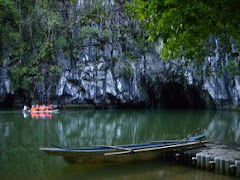
The area was inscribed to the World Heritage List based on two natural properties. It features an 8.2 km underground river that flows beneath a spectacular limestone or karst formation before directly emptying into the sea. The lower half of the river is brackish and is affected by the ocean's tides. An underground river that flows directly to the ocean, and the associated tidal influence makes it one of the most unique natural phenomena of its kind to exist. It is said to be the longest navigable underground river in the world.The PPSRNP is only one of the very few places where a full mountain to sea forest ecosystems still exists. These forests ecosystems serve as natural habitats for numerous wildlife species and are significant for biodiversity conservation. The Park represents Palawan’s moist forest that has been noted by the WWF as having the richest tree flora in Asia with high levels of regional and local endemism. The Park is one of the five Important Bird Areas (IBA) of Palawan which has been identified as one of the 7 Endemic Bird Areas (EBA) of the Philippines by Birdlife International. It is inhabited by 5 internationally threatened bird and 1 internationally threatened mammal species. The Park is inhabited by the Philippine cockatoo (Cacatua haematuropygia) and the Palawan peacock pheasant (Polyplectron emphanum) two internationally threatened species.
Although establish earlier, management of the Park began in 1979 when staff from the Ministry of Natural Resources were assigned to the area. Management was transferred to the Department of Environment and Natural resources Region IV Office. In 1988, the Philippine Government entered into an agreement with the World Wildlife Fund (WWF) by signing a Memorandum of Agreement (MOA) for a Debt-for-Nature-Swap Program (DFNSP). Under the scheme, the WWF will assume responsibility to a portion of the Philippine Government external obligation; in return the Government shall invest the same amount for the conservation of the environment. The Park was fortunate to become one of the three areas to benefit from the program which eventually involved the Haribon Foundation and the Philippine Business for Social Progress.



